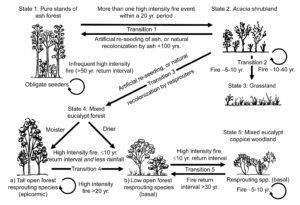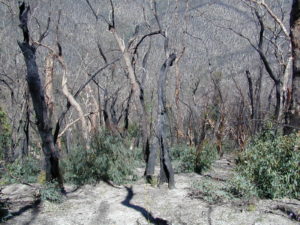Montane Forests
In regions prone to wildfire, a major driver of ecosystem change is increased frequency and intensity of fire events caused by a warming, drying climate. Uncertainty over the nature and extent of change creates challenges about how to manage ecosystems subject to altered structure and function under climate change.
Using montane forests in south-eastern Australia as a case study, we addressed this issue by developing an ecosystem state-and-transition model based on fire frequency and intensity. In this model, changes in fire frequency are linked to changes in vegetation communities.

Vegetation state-and-transition model for temperate montane forests in mainland south-eastern Australia in relation to fire frequency and intensity
With intense fires recurring at intervals of less than 20 years, it is likely that mountain ash and alpine ash will not regenerate because these trees only reproduce by seed and take about 20 years to become sexually mature. Ash forest is likely to transition to Acacia scrubland. With increasing fire frequency, Acacia scrubland is likely to transform to grassland. In contrast to the ash species, other forest eucalypts regenerate after fire by producing shoots either along the stem or from the base. These ‘resprouter’ species may exist in tall, closed forest configuration or more open woodland communities.

Mixed coppice woodland of basal resprouter species: broad-leaved peppermint Eucalyptus dives and brittle gum E. mannnifera, one year after fire, Brindabella Ranges, New South Wales
Each of the vegetation communities provides a different set of ecosystem services. The range and supply of these services is likely to change quite markedly as the forest becomes a mosaic of different vegetation communities, including those without forest cover, under increasing fire frequencies.
We then undertook an analysis of the interactions between societal values, scientific and management knowledge and institutional rules (vrk) required to reframe the decision context for future management, and determined possible options for an adaptation pathway for management of montane forests under climate change.
Our approach is transferable to other ecosystems for which alternative states can be predicted under climate change.
For more information:
Colloff, M.J., Doherty, M.D, Lavorel, S., Dunlop, M., Wise, R.M. & Prober, S.M. (2016) Adaptation services and pathways for the management of temperate montane forests under transformational climate change. Climatic Change 138, 267-282. http://dx.doi.org/10.1007/s10584-016-1724-z
Doherty, M.D., Lavorel, S., Colloff, M.J., Williams, K.J. & Williams, R.J. (2016) Moving from autonomous to planned adaptation in the montane forests of southeastern Australia under changing fire regimes. Austral Ecology 42, 309-316. http://dx.doi.org/10.1111/aec.12437
